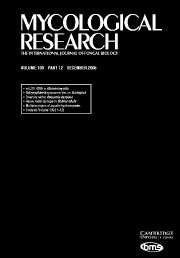Crossref Citations
This article has been cited by the following publications. This list is generated based on data provided by
Crossref.
Avis, T. J.
Caron, S. J.
Boekhout, T.
Hamelin, R. C.
and
Bélanger, R. R.
2001.
Molecular and Physiological Analysis of the Powdery Mildew Antagonist Pseudozyma flocculosa and Related Fungi.
Phytopathology®,
Vol. 91,
Issue. 3,
p.
249.
Fell, J. W.
Boekhout, T.
Fonseca, A.
and
Sampaio, J. P.
2001.
Systematics and Evolution.
p.
3.
Bauer, R.
Begerow, D.
Oberwinkler, E.
Piepenbring, M.
and
Berbee, M. L.
2001.
Systematics and Evolution.
p.
57.
Takashima, Masako
and
Nakase, Takashi
2001.
Tilletiopsis derxii, Tilletiopsis oryzicola and Tilletiopsis penniseti, three new species of the ustilagionomycetous anamorphic genus Tilletiopsis isolated from leaves in Thailand.
Antonie van Leeuwenhoek,
Vol. 80,
Issue. 1,
p.
43.
Begerow, Dominik
Bauer, Robert
and
Oberwinkler, Franz
2001.
Muribasidiospora: Microstromatales or Exobasidiales?.
Mycological Research,
Vol. 105,
Issue. 7,
p.
798.
Bauer, Robert
Begerow, Dominik
Nagler, Apollonia
and
Oberwinkler, Franz
2001.
The Georgefischeriales: a phylogenetic hypothesis.
Mycological Research,
Vol. 105,
Issue. 4,
p.
416.
Theelen, Bart
Silvestri, Massimiliano
Guého, Eveline
Belkum, Alex
and
Boekhout, Teun
2001.
Identification and typing ofMalasseziayeasts using amplified fragment length polymorphism (AFLPTm), random amplified polymorphic DNA (RAPD) and denaturing gradient gel electrophoresis (DGGE).
FEMS Yeast Research,
Vol. 1,
Issue. 2,
p.
79.
Piepenbring, Meike
Stoll, Matthias
and
Oberwinkler, Franz
2002.
The generic position of Ustilago maydis, Ustilago scitaminea, and Ustilago esculenta (Ustilaginales).
Mycological Progress,
Vol. 1,
Issue. 1,
p.
71.
Vánky, K.
2002.
The smut fungi of the world. A survey.
Acta Microbiologica et Immunologica Hungarica,
Vol. 49,
Issue. 2-3,
p.
163.
Begerow, Dominik
Bauer, Robert
and
Oberwinkler, Franz
2002.
The Exobasidiales: An evolutionary hypothesis.
Mycological Progress,
Vol. 1,
Issue. 2,
p.
187.
Avis, Tyler J
and
Bélanger, Richard R
2002.
Mechanisms and means of detection of biocontrol activity ofPseudozymayeasts against plant-pathogenic fungi.
FEMS Yeast Research,
Vol. 2,
Issue. 1,
p.
5.
Begerow, Dominik
Lutz, Matthias
and
Oberwinkler, Franz
2002.
Implications of molecular characters for the phylogeny of the genus Entyloma.
Mycological Research,
Vol. 106,
Issue. 12,
p.
1392.
BOEKHOUT, TEUN
and
PHAFF, HERMAN J.
2003.
Yeasts in Food.
p.
1.
Boekhout, Teun
Theelen, Bart
Houbraken, Jos
Robert, Vincent
Scorzetti, Gloria
Gafni, Aviva
Gerson, Uri
and
Sztejnberg, Abraham
2003.
Novel anamorphic mite-associated fungi belonging to the Ustilaginomycetes: Meira geulakonigii gen. nov., sp. nov., Meira argovae sp. nov. and Acaromyces ingoldii gen. nov., sp. nov..
International Journal of Systematic and Evolutionary Microbiology
,
Vol. 53,
Issue. 5,
p.
1655.
Maier, Wolfgang
Begerow, Dominik
Weiß, Michael
and
Oberwinkler, Franz
2003.
Phylogeny of the rust fungi: an approach using nuclear large subunit ribosomal DNA sequences.
Canadian Journal of Botany,
Vol. 81,
Issue. 1,
p.
12.
Stoll, Matthias
Piepenbring, Meike
Begerow, Dominik
and
Oberwinkler, Franz
2003.
Molecular phylogeny of Ustilago and Sporisorium species (Basidiomycota, Ustilaginales) based on internal transcribed spacer (ITS) sequences.
Canadian Journal of Botany,
Vol. 81,
Issue. 9,
p.
976.
Kiss, Levente
2003.
A review of fungal antagonists of powdery mildews and their potential as biocontrol agents.
Pest Management Science,
Vol. 59,
Issue. 4,
p.
475.
Begerow, Dominik
John, Beate
and
Oberwinkler, Franz
2004.
Evolutionary relationships among β-tubulin gene sequences of basidiomycetous fungi.
Mycological Research,
Vol. 108,
Issue. 11,
p.
1257.
Lutz, Matthias
Bauer, Robert
Begerow, Dominik
and
Oberwinkler, Franz
2004.
Tuberculina — Thanatophytum/Rhizoctonia crocorum — Helicobasidium: a unique mycoparasitic-phytoparasitic life strategy.
Mycological Research,
Vol. 108,
Issue. 3,
p.
227.
Andrade, Orlando
Muñoz, Gastón
Galdames, Rafael
Durán, Paola
and
Honorato, Rodrigo
2004.
Characterization, In Vitro Culture, and Molecular Analysis of Thecaphora solani, the Causal Agent of Potato Smut.
Phytopathology®,
Vol. 94,
Issue. 8,
p.
875.

